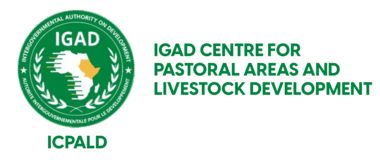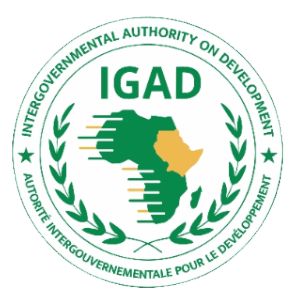1. Background
The 3rd Regional Integration Support Programme (RISP3) is a follow-up phase to RISP1 (2005-2010) and RISP2 (2010 – 2013). The RISP3 programme seeks to support well selected, high priority and complementary activities to accelerate domestication and implementation of regional commitments including targeted national consultations and consensus building, background analytical work, reviews to identify gaps between current national laws and regional commitments, drafting of new legislation to comply with regional decisions, and strengthening national and regional institutions involved in coordination and implementation of regional integration activities. The main instruments of the IGAD support to member states will be capacity development, information gathering and analysis, advocacy and promotion of issues, and promotion of appropriate policy and intervention development in member states.
ICPALD within its mandate to facilitate and promote sustainable and equitable drylands and livestock development in the region including alternative livelihood resources has convened in Khartoum, Sudan a regional experience sharing event on artisanal mining. Despite the fact that livestock remains the principal source of livelihood in the ASALs, the future lies with the combinations of livestock and exploitation of products from ASALs including non-wood forest products and minerals. This event was meant to contribute to wealth and employment opportunities and alternative livelihoods in the ASALs by observing, interacting and sharing information on good practices about artisanal minerals with emphasis on gold mining.
2. Objectives
The overall objective of the mission was to strengthen information sharing and promote learning by practice on artisanal mining in the region. Other specific objectives include:
- Provide space/platform for mutual learning and sharing of practical experiences.
- Highlight the importance of sharing information and experiences on artisanal mining
- Share views and experiences on the status, challenges and opportunities and finding regional and localized solutions to the challenges.
- Learn from each others’ experiences
3. Expected outputs
- A platform of learning from doing on AM was created,
- Awareness on AM and its role in the livelihood of rural communities in ASALs increased;
- Information and experiences shared, best practices documented and shared.
4. Methodology
Generally, the event adopted the participatory discussion approach with emphasis on:
- Presentations on information and experiences
- Field trips
- Plenary and field discussions
5. Proceedings
Official opening was done by Director General, Geological Research Authority, Ministry of Minerals, Sudan after welcoming remarks from Dr Solomon Munyua, Ag Director, ICPALD. Other proceedings included presentations on general overview about artisanal mining in the region, Sudan experience, and other countries’ experiences. Then field visits started by visiting the technical arm of the Ministry of Minerals, Sudan, Geological Research Authority. This was followed by visiting Ariab Company which is a joint venture between the government and the private sector. The second day was devoted to a field visit to a mining place in River Nile State, 350 Km north of Khartoum.
In nutshell, the following were some major discussed and shared information during the two days of the event:
- At global, continental and regional levels, artisanal mining is a reality and it is very important as it contributes enormously to individuals, households and the national economies.
- In IGAD region, on average, more than 3 million people benefit directly from artisanal mining. This in addition to a range of 15 – 18 million indirect beneficiaries including members of households, local traders, processors and end market traders.
- Djibouti has the world’s largest salt reserves in Lake Assal in the Tadjoura region, it is the lowest point on land in Africa. Gold, salt and construction materials are among the minerals found in Djibouti. Artisanal mining of gold, perlite, gypsum, and pumice is practiced on small scale production.
- In Ethiopia, the ministry responsible from mining is the Ministry of Mines, Petroleum and Natural Gas. Mining licenses are usually issued by the regional authorities, artisanal mining is incorporated in the Mineral Policy, recognized in the mining law, incorporated in the poverty reduction strategy and mining proclamation is revised in favour of artisanal mining. More than 100,000 miners are organized into cooperatives, and more than 50,000 are organized into micro and small scale miners all over the country. The amount of gold purchased by the National Bank of Ethiopia increased from 735 kg of gold in 2009 to 8386 kg in 2015.
- In Kenya, artisanal mining falls within the mandate of Ministry of Mining. A wide range of minerals both metallic and non-metallic occur including gold, gemstones, gypsum, fuorite, soda, limestone iron, etc. Gold mining is undertaken by two medium scale, and about 30 exploration companies. The artisanal miners are community based miners working out of their farms and freelance miners who move from place to place looking for quick pick. This gold mining was estimated at 200kg per year, with average earnings of USD 5 – 8 million per year. Interventions by government include recognition of artisal mining by the mining policy, public education, encouraging formation of miners associations and training opportunities.
- In Somalia, sepiolite rudimentary artisanal mining is practiced for centuries, with huge reserves in central Somalia and it is used for cooking stoves, smoking pipes and for decoration purposes.
- In South Sudan, artisanal mining is under Ministry of Petroleum and Mining. It is very active in the crystalline rock parts of the country. It is a quick generating activity run by individuals and households especially along the streams and rivers. The Mining Act 2012 gives the Ministry the mandate to provide technical and advise support to artisanal miners at state and country level.
- In Sudan, Ministry of Minerals is mandated to develop, organize and formalize the artisanal mining among other functions. During 2015, the Ministry issued about 59 licenses, 221 contracts and about 221 sites of artisanal mining in 12 states of the 18 states of Sudan. On average, in 2015 more than 50,000 kg of gold produced by artisanal miners.
- In Uganda, the Ministry responsible is Ministry of Energy and Mineral Development. Artisanal mining is practiced as un-mechanized, unlicensed, and disorganized subsitence mining. Now it starts to show some signs of improvement in technology and registeration.
- In Sudan the Authority of Geological Research acts as a technical arm to the Ministry of Minerals. It carries out research and prospecting for minerals through geological, geophysical and geochemical studies. It develop maps, offer advisory services and technically supervise mining operations and extraction.
- The Gold Refinery Unit is established in 2012 as a public company owned by Ministry of Finance, Central Bank of Sudan and Ministry of Minerals. It uses a chemical method known as the Royal Water System in gold extraction. This is healthy, environment friendly and non-harmful to humans. The Central Bank buys around 350 kgs of gold from traditional miners and the refinery undertakes refining of 400 – 500 kg for them.
- Established in 1991, Ariab has been a joint venture between Government of Sudan and a Canadian French Company, now turned into 95% for Sudan Government and 5% for the Industrial Development Bank. The average annual gold production was ranging around 5.2 tons of fine gold per annum. The Company has significantly contributed to the development of the surrounding areas and local communities as part of its corporate social responsibility.
- During the visit to the mining place, we learnt that artisanal mining is practiced at about 20 sites in a range of 500,000 – 1000,000 artisanal miners, and dependents estimated as more than 5 million people. The artisanal mining is organized along 4 main markets which represent another venue for employment creation. Issues of regulation, licenses, safeguarding the environment, health, grouping of workers and the like are all considered in Mineral Development Law, 2007.
Conclusion/Recommendations
- As artisanal mining may extend up to the agricultural and grazing lands, it should be noticed that peoples’ rights and land tenure issues come at the front during planning and implementation of artisanal mining licenses.
- ICPALD to assist on developing the artisanal mining strategy in the region.
- Prior consideration should be given to issues of policy, legalization, involvement of the private sector, group formation, value addition and ecological approach principles.
- Formalization of artisanal mining needs to be considered as it eases access to finance, extension service, basic services, increases government revenues, decreases smuggling, creates peace and stability and stimulates other economic sectors.
- Some priorities need consideration such as awareness creation, gender and child labour issues, school dropouts, impacts on animal and crop agriculture and addressing of risks and hazards.






